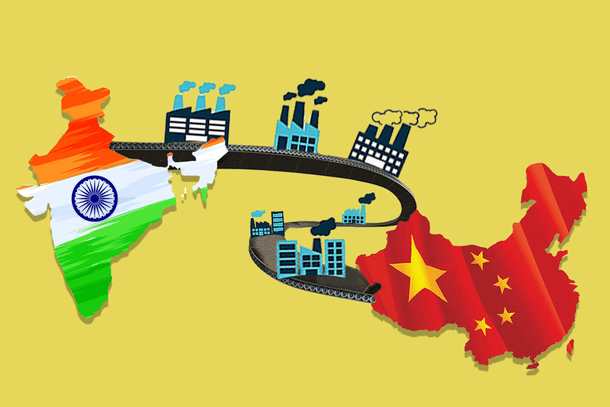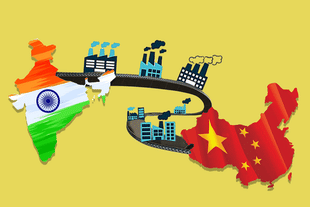Economy
The Great Disruption: How China Is Stalling India's Industrial Ascent
Amit Mishra
Jan 17, 2025, 04:55 PM | Updated Feb 01, 2025, 02:35 PM IST
Save & read from anywhere!
Bookmark stories for easy access on any device or the Swarajya app.


China-India relations are teetering on the edge of a new storm — this time, not along their contentious borders but deep within the economic ties that bind and strain them.
The latest flashpoint? Major delays in the shipment of specialised manufacturing equipment from Chinese ports to India, threatening to derail India’s ambitious push to boost its domestic manufacturing sector.
With the stakes rising, both Apple and Foxconn India have called on the Indian government for urgent intervention. While production remains unaffected for now, insiders warn that prolonged delays could jeopardise Apple’s ambitious manufacturing expansion plans in India.
But it’s not just Apple. Electronics companies across the board are feeling the squeeze. In a swift response, the Ministry of Electronics and Information Technology (MeitY) has raised the alarm with the Ministry of External Affairs (MEA), highlighting the broader ramifications of these troubling bottlenecks.
Technology publication Rest of World recently reported that Foxconn, the Taiwanese manufacturing giant traditionally focused on Apple production in China, is facing serious obstacles as it shifts operations to India.
Chinese staff are unable to travel to Foxconn’s iPhone factories in India, while Chinese workers already stationed there are reportedly being recalled.
“Currently, the equipment and manpower are not allowed to go over [to India],” one of the sources told Rest of World. “And India doesn’t have the technology to produce the equipment.”
Though Apple and Foxconn have yet to comment publicly, the nonprofit publication cites sources who claim that the Chinese government is behind the suspension of worker deployments and equipment exports.
A Multi-Sector Assault
This isn’t the only covert move China is making to hinder India’s industrial progress.
Key sectors that rely heavily on Chinese imports, such as solar panels and electric vehicles (EVs), are now grappling with severe difficulties in securing essential capital equipment, including high-technology machinery, as China has nearly halted supplies.
China is a crucial hub for tunnel boring machines (TBMs). It has recently started blocking sales of these crucial machines to India, throwing vital infrastructure projects into turmoil.
The situation escalated to the point where Commerce Minister Piyush Goyal warned Germany’s Vice Chancellor, Robert Habeck, that India may have no choice but to stop purchasing German-made TBMs if China continues to obstruct these critical sales.
In the pharmaceutical sector, where India's production-linked incentive (PLI) scheme is driving the creation of alternative supply chains for active pharmaceutical ingredients (APIs), drug intermediates (DIs), and key starting materials (KSMs), Chinese companies are ramping up their use of predatory pricing tactics to derail India’s progress.
Recently, key APIs like paracetamol, penicillin, sitagliptin, metformin, and telmisartan have experienced sharp price drops, fueling concerns within the industry.
Industry insiders point to these price cuts as a calculated effort by Chinese companies to destabilise India’s emerging pharmaceutical sector, casting doubt on the country’s ability to stabilise prices and build a resilient domestic supply chain.
Similarly, India’s clean energy ambitions are under siege, with Chinese predatory pricing undermining the country’s efforts to bolster domestic manufacturing under the PLI scheme.
“Let’s be clear: imported solar modules and cells are being dumped from China, and this anti-competitive behavior has distorted market pricing. Chinese solar manufacturers are selling their products at prices below the cost of production due to systemic overcapacity in Chinese crystalline silicon solar supply chains,” said Sujoy Ghosh, Vice President and Managing Director of First Solar’s India operations, in an interview with The Indian Express.
The numbers tell a stark story: In June 2024, imported solar modules from China were priced at an average of 9.1 cents per watt, compared to 18 cents per watt for domestically produced modules, according to credit rating agency CRISIL. This price gap highlights the challenges for Indian manufacturers to compete on a level playing field.
To make matters worse, China has stepped up its retaliation against India’s import restrictions. In response to India’s anti-dumping probe into Chinese entities, Beijing has quietly begun blocking India’s access to critical solar equipment, further disrupting the manufacturing landscape for Indian industries.
Pressing Concern
China’s dominance over a large number of product categories creates a risk of economic coercion, where the government restrains access to crucial inputs for political leverage.
Nowhere is this more apparent than in the export of rare earth and critical minerals, which are of high priority in the green transition efforts of countries.
A striking example of this tactic occurred over a decade ago when China restricted rare earth exports to Japan amid a territorial dispute over the East China Sea. More recently, Beijing imposed export controls on germanium and gallium, two critical minerals in high-tech manufacturing.
China’s near-monopoly over the production and processing of rare earth and critical minerals is an even graver concern, especially for countries pursuing ambitious renewable energy goals.
For India, this dependency is a glaring vulnerability, threatening the foundation of its wind, solar, and EV industries.
"Their restricting critical mineral exports to India through a combination of market-share control over rare earths resources as well as their extraction and processing, and through tighter export controls,... is a distinct possibility in the foreseeable future that needs to be closely monitored," warns former foreign secretary Vijay Keshav Gokhale.
Such measures, he notes, could strategically delay India’s efforts to indigenise its clean energy supply chain.
Going Overboard
Amid industrial overcapacity issues at home and an economic growth slowdown, China’s covert application of industrial "sanctions," particularly on EVs and hi-tech goods, reveals a nuanced and calculated strategy.
At its core lies Beijing’s growing unease over India’s ambitions to emerge as the next global manufacturing hub — a fear amplified by Apple’s successful shift of iPhone production to India. This transition signals a broader shift that threatens China’s dominance in the global supply chain.
"China wants India to be an integral part of its own supply chain rather than a substitute for it. Different methods are being applied in the pursuit of this strategic objective," writes Gokhale.
Kyle Chan, a postdoctoral research associate at Princeton University specialising in industrial policies in China and India, echoes this sentiment. Speaking to Rest of World, he noted that the Chinese government may be alarmed by the manufacturing shifts, particularly to India.
“Maybe China is surprised, as many people were, by how quickly Apple was able to actually move some of its iPhone production to India,” Chan remarked, speculating that Beijing could use these moves to remind United States (US) companies of its (China's) leverage in the global market.
Apple’s move to diversify its supply chain has become a showcase of manufacturing success that is likely to attract other tech giants, particularly in critical sectors like semiconductors. China, therefore, may be wary of India scaling up its domestic manufacturing too quickly, particularly in sectors of strategic importance.
Beyond the supply chain rivalry, China’s actions in industries like pharmaceuticals and solar equipment also stem from its looming overcapacity crisis. Faced with an economic slowdown, Chinese manufacturers are under pressure to export surplus goods at low prices.
Trouble spots in the world’s second-largest economy were expected to pressure Chinese manufacturers into shipping excess factory goods outside at low prices, per the views voiced at the Mercator Institute for China Studies (Merics) 6th China Forecast conference.
If that is not enough, China’s dominance also has led to monopolistic practices, which has considerably limited the space for new entrants to emerge as new manufacturing powers.
Recent research by Rhodium Group observes: “The Chinese government can encourage companies to partner together, merge and consolidate, coordinate to gain market shares, raise prices, restrict access to products where they already have substantial market power, or favour domestic firms in their suppliers and client networks.”
These practices create formidable barriers for new players, limiting opportunities for countries like India to carve out a competitive space in critical sectors.
What Lies Ahead
China’s protectionist tactics are more than just a roadblock — they are a calculated strike at India’s ambitions to emerge as a global manufacturing leader. These moves not only drive up costs for Indian manufacturers but also threaten to unravel the entire narrative of self-reliance.
And make no mistake — this is only the opening act of Beijing’s strategic playbook. This subtle and undeclared coercion will need concerted action on the part of both the government and industry, as Gokhale points out.
Every iPhone assembled in India, every solar panel produced, and every semiconductor chip manufactured represents more than just progress — they’re statements of intent, symbols of a rising power challenging the status quo.
To truly seize this moment, India must focus on cultivating self-reliance in critical sectors like high-tech manufacturing and rare earth mineral processing — fields where China currently dominates.
In the immediate term, however, New Delhi faces an uphill battle to navigate this crisis. The dual approach of dialogue and deterrence must remain at the forefront of its strategy to counter China’s manoevres, as Gokhale emphasises.
But where will the first flashpoint erupt in 2025? Along the Line of Actual Control, or deep within India’s industrial heartland? That remains anyone’s guess, but one thing is clear: the stakes have been raised higher.





